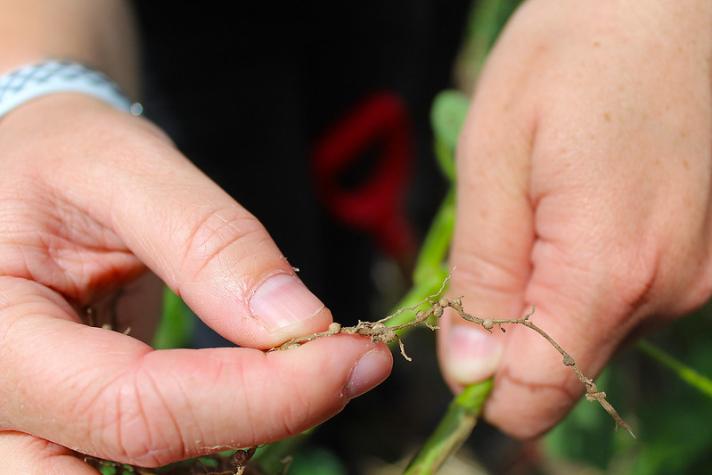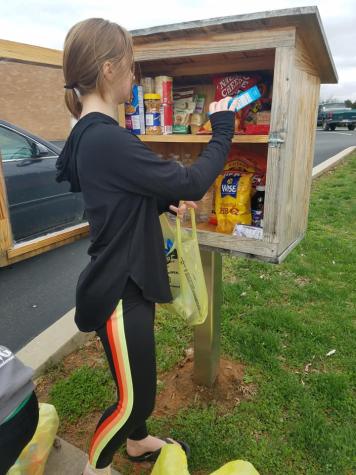
MU clinic offering teleservices for COVID-19 stress
COLUMBIA, Mo. – The University of Missouri Psychological Services Clinic is offering teleservices to help adults and children cope with anxiety and stress related to COVID-19. The clinic offers up to five brief sessions through videoconferencing or telephone, said Debora Bell, longtime director of the clinic.

Test fields for SCN and test your SCN IQ
NEVADA, Mo. – Now is the perfect time to test for the No. 1 soybean disease in the U.S. and Canada - soybean cyst nematode (SCN), says University of Missouri Extension field agronomist Pat Miller. It is also a good time to test your IQ on this yield-reducing disease. Soybean cyst nematodes attack soybean roots.SCN began spreading in Missouri in the 1970s and gained a strong foothold in most of the state’s soybean-growing counties by…
MU Extension specialists on coping with COVID-19's financial impact
Get expert advice on managing the financial impact of COVID-19, including budgeting, debt relief, and financial planning strategies.

Check that mailbox
Packets from MU Extension in Perry County keep homebound kids busy and learning. PERRYVILLE, Mo. – When Bethany Bachmann saw Perry County parents fretting online about how to keep their homebound kids busy and learning, she knew just what to do.

Not letting a pandemic slow us down
All over the nation, people are working online. Missouri’s county extension councils are no exception. Quickly adapting to changing needs, these citizen advisers are now holding their monthly meetings by phone and online videoconference to help make sure University of Missouri Extension can continue its local work.
Freezing offers milk lovers an option for stocking up
COLUMBIA, Mo. – Freezing offers milk drinkers a way to keep nutritious milk on hand at all times, says University of Missouri Extension dairy specialist Reagan Bluel. She works with producers in the heart of southwestern Missouri dairy land.
Try some edgy veggies for a groovy garden this year
COLUMBIA, Mo. – “Create some interest in your garden patch by adding unique vegetables this spring”, said University of Missouri Extension horticulturist David Trinklein.“One of the joys of gardening is trying something new each year,” Trinklein said. Less common vegetables can challenge your gardening skills and tease your taste buds. They also can disappoint, so center your garden on tried-and-true favorites, he says.

Connecting and protecting Knox County
EDINA, Mo. – Jennifer Eldridge Houser never imagined that her Ph.D. in public health education would be put to such urgent use for Knox County’s 5,000 residents. After years of teaching epidemiology at Truman State University, Eldridge knew just how to respond when a global pandemic put communities across Missouri on high alert.

Go wild at nature's free salad bar
Discover the art of wildcrafting and enrich your diet with Missouri's edible spring greens like dandelions, lambsquarters, and watercress.
10 tips for communicating with employees during a crisis
These suggestions are provided to assist you, but in sharing them, we recognize that each business and situation is unique. We encourage you to consider each principle and apply as you believe best fits your business situation and your relationship with your employees. 1. Communicate even more during a crisis

ShowMeResilience in Madison County: 'No need for anyone to go hungry'
University of Missouri Extension in Madison County powered into high gear as soon as news went out last week that the Fredericktown schools were closing. “‘How are we going to fill in the gaps? Because we know there will be big gaps in services in our county and communities.’ That was our first thought,” said Shanna Sorg, a nutrition and health education specialist serving Iron, Madison and Reynolds counties in southeastern Missouri.
Show Me Resilience
Show Me Resilience. In challenging times, Missourians come together. This simple phrase illustrates how University of Missouri Extension and communities across the state are showing up for each other. People, businesses and communities across Missouri are working together in innovative and engaging ways – bringing the resources of the University of Missouri to the people who need them.

Pansy: A flower for all seasons
COLUMBIA, Mo. – If there’s a plant that deserves the title of “flower for all seasons,” it is the pansy, says University of Missouri Extension horticulturist David Trinklein. At any given time in North America, you will find pansies blooming prolifically somewhere. This cool-loving garden flower flourishes in winter in far southern states and in summer in northern regions. Midwesterners enjoy pansy’s unique palette of colors and…

Duane Dailey: 1935-2020
Several years before his death on March 10, 2020, Duane Dailey drafted his own obituary. We present it here with only minor updates.Fred “Duane” Dailey, 84, will meet his final deadline as a longtime agricultural journalist. He was a University of Missouri Extension educator who had taught through the news media.

Betty Hertzog Memorial 4-H Endowment sends Missouri youths to State 4-H Congress
COLUMBIA, Mo. – Future generations will have the opportunity to attend State 4-H Congress thanks to the generosity of Robert E. “Bud” Hertzog and his late wife, Betty Hertzog, who passed away Oct. 14, 2019.
Donors help launch Barton County 4-H endowment fund
COLUMBIA, Mo. – The Missouri 4-H Foundation, in partnership with the Barton County 4-H Council, has established the Barton County 4-H Endowment Fund thanks to generous contributions by the Hugh and Fran Nutt family and Don Lucietta. The fund will be used to provide sustainable support for the Barton County 4-H program in perpetuity.

Outreach, innovation at UM Science Center Day
University of Missouri faculty, staff, and students showcased their work through engaging hands-on activities during UM Science Center Day in St. Louis.

Dr. Bug answers questions you're itching to ask about mosquitoes
KANSAS CITY, Mo. – University of Missouri Extension field horticulture specialist Tamra Reall answers questions that are “bugging” youngsters. Mama mosquitoes
Hibby’s Sports Grille — West Plains, MO
While living in West Plains, Missouri in 2012, Mike Hibler noticed a need for a restaurant where he could enjoy good food and watch a sports game. On his way to work every day, he noticed an abandoned building that looked like a log cabin. He always imagined what he could turn the building into, and one day, he decided to pitch the idea to his wife, Stephanie, and his mother, Cheryl.
The three pricing strategies for small business owners
A question that frequently comes up in my counseling sessions is, “What can I charge for this?” After a few discussions and cost gathering, we arrive at a true cost. Honestly, there are only three pricing strategies a small business owner can use in any situation: everyday low price (EDLP); high price, high value; and market parity.
Who really are your customers?
When I was in the advertising business, I would always ask my clients, “Who are your customers?” “Everyone” was a common response. Even if I questioned further, I received the same response. I would finally start to talk about categories — like their most frequent customers or those who only came in at specific times of the year — and we would start to get a better picture.
Coupons still a solid small business sales strategy
Coupons are the most common sales promotional tool used by businesses. Their usage continues to grow each year, as they provide a way for the consumer to save money while offering the retailer a way to grow and retain sales. The coupon has consistently proven to be an effective business tool.
How to set your business apart from your competition
As I spend time with friends, I often hear them say, "There is no unique place to go shop these days. They all have the same stuff." To which I reply: "Why do you shop where you do?" This at times leads to an interesting dinner conversation. But it always reminds me that many business owners may not know how to set themselves apart from the competition at little or no cost.
Small business succession planning means success in small towns
Many small rural towns in Missouri have a large population of aging baby boomers. They are retiring at the rate of 10,000 per day or over 4 million annually, according to the Washington Post. But what are they doing with their business assets when they retire?
Where did my cash go?
That's a question many small business owners ask themselves way too often. In other articles, I have written about balance sheets and income statements as financial tools to help entrepreneurs manage their businesses. But what if that entrepreneur could predict how much cash would be coming into and going out of the business on a monthly basis? Or better yet, be able to look months down the road and have an idea of the intake and…
